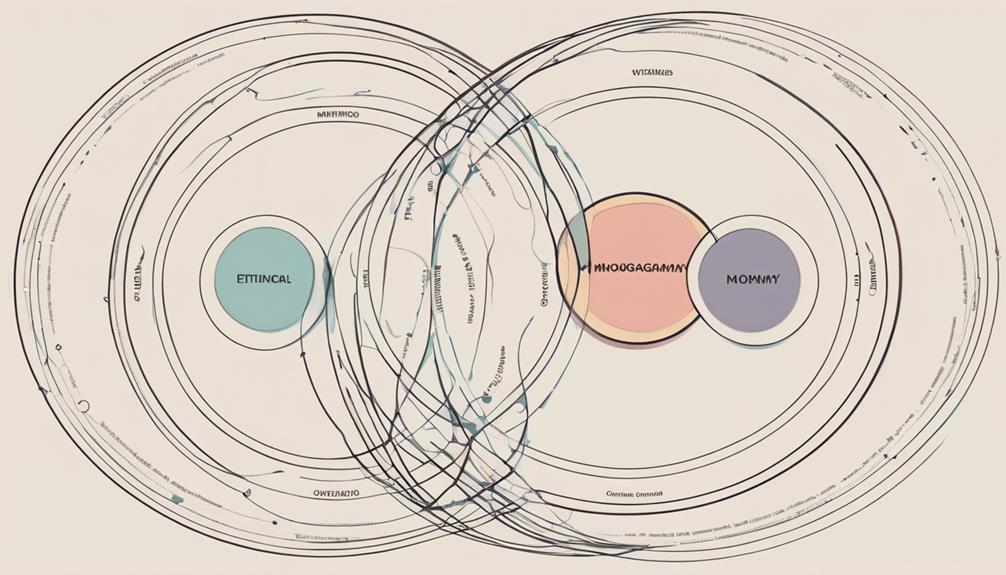Let’s explore the complex world of ethical non-monogamy and polyamory, like unraveling threads in a intricate tapestry.
As we unravel the distinctions between these two relationship structures, it becomes apparent that nuances exist beyond mere labels.
Understanding the intricacies of ethical non-monogamy versus polyamory can shed light on the diverse ways individuals navigate intimate connections.
Whether you are familiar with these concepts or new to the discussion, exploring the differences between ethical non-monogamy and polyamory promises a journey of self-discovery and reflection.
Key Takeaways
- Ethical non-monogamy allows diverse relationship structures; polyamory focuses on multiple romantic connections.
- Understanding distinctions aids in navigating complexities of non-monogamous dynamics effectively.
- Polyamory requires higher emotional involvement; ethical non-monogamy emphasizes consensual participation.
- Both challenge traditional norms, encouraging exploration of preferences in ethical and respectful ways.
Ethical Non-Monogamy Explained
In ethical non-monogamy, we embrace consensual engagement in multiple romantic or sexual relationships with honesty and open communication. This foundation of trust allows us to navigate the complexities of our diverse relationship needs.
Respect for boundaries and agreements is paramount, ensuring that all parties involved feel valued and heard. By upholding these principles, we differentiate ethical non-monogamy from infidelity, as transparency and honesty are the cornerstones of our interactions with multiple partners.
Through this approach, we create a space where everyone's feelings and desires are taken into account, fostering a sense of security and understanding within our relationships. Whether practicing polyamory, engaging in open relationships, or exploring other forms of ethical non-monogamy, the emphasis on consensual participation and clear communication remains constant.
Polyamory Defined

Defined as engaging in intimate, emotional, and sexual relationships with multiple partners simultaneously, polyamory emphasizes commitments and connections in a romantic context.
In polyamorous relationships, individuals prioritize developing loving relationships with more than one person, fostering deep emotional bonds and romantic involvement with multiple partners. This form of non-monogamy requires a higher level of emotional involvement and commitment compared to other relationship structures.
Participants in polyamorous relationships navigate the complexities of balancing the needs and desires of multiple partners while nurturing intimacy and communication within each relationship. Polyamory challenges traditional notions of monogamy by advocating for the possibility of loving more than one person simultaneously and encourages open and honest communication to ensure all individuals involved feel valued and respected.
Key Differences Between ENM and Polyamory
Exploring the nuances of Ethical Non-Monogamy (ENM) and Polyamory reveals distinct differences in relationship structures and dynamics. ENM encompasses various consensual non-monogamous relationships, including polyamory, but the two have key disparities:
- ENM's Versatility: ENM allows for a wide range of relationship structures, such as open relationships, polyfidelity, and relationship anarchy, accommodating different preferences and dynamics.
- Polyamory's Emotional Focus: Polyamory emphasizes multiple romantic relationships with deep emotional involvement, prioritizing intimate connections and emotional commitment.
- ENM's Diversity: While polyamory centers on developing intimate bonds with multiple partners, ENM acknowledges the diversity of relationship styles within non-monogamous setups, recognizing that not all connections need to be romantic or emotionally intense.
Understanding these distinctions can help individuals navigate the complexities of non-monogamous relationships, enabling them to tailor their experiences based on their unique preferences and boundaries.
Navigating Relationship Dynamics

Let's delve into the intricacies of navigating relationship dynamics in non-monogamous contexts. In the realm of ethical non-monogamy and polyamory, understanding the nuances of various relationship structures is essential for fostering healthy connections. Here is a comparison table to shed light on the diversity within non-monogamous relationships:
| Dynamics | Description |
|---|---|
| Open Relationships | Involves partners having consensual non-monogamous relationships outside the primary partnership. |
| Polygamy | A form of non-monogamy where individuals have multiple spouses simultaneously. |
| Swinging | Couples engaging in sexual activities with others as a recreational or social activity. |
| Triads | Three individuals forming a closed, committed relationship together. |
| Polyfidelity | A group of individuals who are romantically and sexually exclusive within their circle. |
Navigating relationship dynamics in ethical non-monogamy and polyamory requires establishing clear boundaries, fostering open communication, and building trust among all parties involved. By embracing these principles, individuals can create fulfilling and sustainable connections in their non-monogamous journey.
Understanding Boundaries and Principles
Navigating relationship dynamics in non-monogamous contexts requires a deep understanding of boundaries and principles, especially in ethical non-monogamy and polyamory. In ethical non-monogamous relationships, clear boundaries and principles play a crucial role in maintaining trust and harmony among all partners.
- Establishing Boundaries: Setting clear agreements on emotional and sexual involvement with multiple partners is essential to ensure that all individuals feel valued and respected.
- Emphasizing Principles: Upholding principles such as consent, honesty, and respect for everyone involved creates a foundation of trust and mutual understanding in ethical non-monogamous dynamics.
- Fostering Communication: Open communication is key to navigating relationships in ethical non-monogamy, as it allows partners to express their needs, desires, and concerns openly and honestly.
Frequently Asked Questions
What Is the Difference Between Poly and Ethical Non-Monogamy?
When we talk about the difference between polyamory and ethical non-monogamy, it's crucial to understand that polyamory specifically focuses on multiple romantic relationships with a strong emphasis on emotional connections.
On the other hand, ethical non-monogamy encompasses all forms of non-monogamous relationships that prioritize open communication and consent.
Both involve multiple partners, but polyamory often requires deeper emotional involvement and commitment compared to other ethical non-monogamous relationships.
Why Is Polyamory Ok but Not Polygamy?
Polyamory is accepted over polygamy due to its emphasis on equality, consent, and communication. Society favors polyamory for promoting honesty and respect among all partners, ensuring everyone's needs are met. It's about building emotional connections and valuing romantic involvement, making it more socially acceptable.
Polygamy lacks these ethical foundations and can be based on traditional or religious norms that don't prioritize equality and consent.
How Do You Understand Enm?
We see ENM as a way to engage in multiple relationships with honesty and respect for boundaries. It involves open communication and consent among all parties, ensuring everyone is aware and accepting of the situation.
ENM can encompass various scenarios where partners have agreed-upon boundaries, allowing for connections outside their primary relationship. It's about prioritizing transparency, communication, and ethical behavior to distinguish it from cheating or infidelity.
What Are the Key Differences Between Non-Monogamous and Monogamous Relationships?
We believe it's essential to recognize the distinct differences between non-monogamous and monogamous relationships.
In non-monogamous relationships, individuals engage with multiple partners, challenging the traditional norm of exclusivity to one person. This allows for diverse forms of connections and varying levels of commitment.
On the other hand, monogamous relationships emphasize exclusivity and dedication to a single partner, reflecting a more conventional approach to intimacy and partnership.
– Can Poly Relationships Be Considered Ethical Non-Monogamy?
Yes, poly relationships can be considered a form of ethical nonmonogamy. In a polyamorous relationship, all parties involved are aware of and consent to the multiple partnerships involved. It is crucial to maintain open communication, honesty, and respect to ensure that ethical nonmonogamy is practiced within poly relationships.
Conclusion
In conclusion, ethical non-monogamy and polyamory offer diverse relationship possibilities with a focus on communication and respect.
Did you know that a study found that 4-5% of people in the United States have engaged in some form of ethical non-monogamy? This statistic highlights the growing acceptance and exploration of non-traditional relationship structures in society.
It's important to continue educating ourselves and others about these relationship styles to promote understanding and acceptance.
Augustus is the visionary leader and Editor-in-Chief of Personality-Test.net. With an unwavering commitment to quality and authenticity, he oversees all content, ensuring it enlightens and empowers our audience. Augustus believes deeply in the transformative power of self-awareness and is dedicated to making Personality-Test.net a beacon for those on a journey to understand themselves better.










